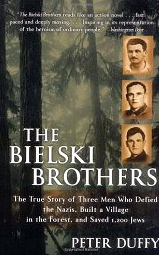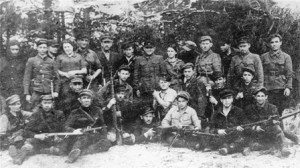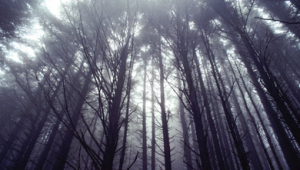“Three men, brothers, saved as many Jews during World War II as Oskar Schindler, and organized a military force that killed hundreds of enemy soldiers, nearly as many as did the fighters of the Warsaw ghetto uprising….In the sixty years since, only a few books have detailed their achievements and hardly a plaque bears their names.”
 When the Germans finally retreated from Belarus in the summer of 1944, almost twelve hundred Jewish survivors of the Holocaust shocked the world by materializing from the forest where they had lived in hiding during the German occupation. Some of these survivors had lived in the forest for more than three years, part of a community established by Tuvia, Asael, and Zus Bielski, three brothers who had chosen to take their chances on survival in the forest rather than submit to the Nazis and their many collaborators. Author Peter Duffy places this extraordinary story of survival in context by describing the Bielskis’ lives and experiences, quoting from Tuvia Bielski’s previously unknown journal, and revealing the sociopolitical history, including the anti-Semitism, of Belarus, a region south of Lithuania.
When the Germans finally retreated from Belarus in the summer of 1944, almost twelve hundred Jewish survivors of the Holocaust shocked the world by materializing from the forest where they had lived in hiding during the German occupation. Some of these survivors had lived in the forest for more than three years, part of a community established by Tuvia, Asael, and Zus Bielski, three brothers who had chosen to take their chances on survival in the forest rather than submit to the Nazis and their many collaborators. Author Peter Duffy places this extraordinary story of survival in context by describing the Bielskis’ lives and experiences, quoting from Tuvia Bielski’s previously unknown journal, and revealing the sociopolitical history, including the anti-Semitism, of Belarus, a region south of Lithuania.
Beginning with the story of the Bielski grandparents, Duffy describes their lives and work as mill-operators, and details the laws which denied them the rights of other Russian citizens during the anti-Semitic rule of Tsar Nicholas II. Required to live in a particular area of Russia and not allowed to own property, the resourceful Bielski family found a gentile friend to act as the “s traw” owner of their mill so that they could continue to operate it and support their family while enduring lives they were powerless to change. Because they lived in the countryside, rather than the city, they were isolated from much of the violence directed, over the years, against Jews in the city, though they were often distrusted and discriminated against by people in their community. When the Germans invaded Belarus during World War II, the ensuing Holocaust was even worse for their grandchildren than anything the grandparents could have imagined.
traw” owner of their mill so that they could continue to operate it and support their family while enduring lives they were powerless to change. Because they lived in the countryside, rather than the city, they were isolated from much of the violence directed, over the years, against Jews in the city, though they were often distrusted and discriminated against by people in their community. When the Germans invaded Belarus during World War II, the ensuing Holocaust was even worse for their grandchildren than anything the grandparents could have imagined.
Tuvia, Asael, and Zus Bielski, leaders of the family in the early 1940’s, found life impossible under the German occupation, but they also realized that it would not get any better if they co-operated with the authorities in any way. Leaving their home under cover of night, they daringly escaped into the forest behind their mill, where they intended to live out the war, if they could. Soon, however, they began bringing others to the forest encampment, and as the community grew larger, Tuvia Bielski required its members to go back into the ghetto to rescue others: “Those who refuse to go into the ghetto [to rescue other Jews] will be the first to go [from this community]. If they do not do it, they do not have any place here with us.”
 Constantly moving the community to new forest locations to avoid detection over the years, the Bielskis found themselves fighting “wars” on four fronts. Their immediate threat was from the Germans and the local police, but they were also in danger from local peasants, many of them collaborators, who were willing to turn them in, rather than supply them with food. They also had to be constantly on the alert, once they made connections with the Russian partisans, that they appeared sufficiently “Communist” and did not reveal their adherence to Jewish traditions, which would have made Tuvia’s important relationship with the partisans suspect. Most of all, they had to guard again
Constantly moving the community to new forest locations to avoid detection over the years, the Bielskis found themselves fighting “wars” on four fronts. Their immediate threat was from the Germans and the local police, but they were also in danger from local peasants, many of them collaborators, who were willing to turn them in, rather than supply them with food. They also had to be constantly on the alert, once they made connections with the Russian partisans, that they appeared sufficiently “Communist” and did not reveal their adherence to Jewish traditions, which would have made Tuvia’s important relationship with the partisans suspect. Most of all, they had to guard again st internal dissension. This was no “utopian community of enlightened democratic and egalitarian governance,” and many readers may cringe at the extremes to which the leadership occasionally resorted in order to eliminate dissension and ensure the survival of the group as a whole.
st internal dissension. This was no “utopian community of enlightened democratic and egalitarian governance,” and many readers may cringe at the extremes to which the leadership occasionally resorted in order to eliminate dissension and ensure the survival of the group as a whole.
At its height, the Bielskis’ forest village consisted of long, camouflaged dugouts for sleeping, a large kitchen, a mill, a bakery, a bathhouse, two medical facilities, a tannery, a school, a jail, and a theater. Tailors, seamstresses, shoemakers, watchmakers, carpenters, mechanics, and experts in demolition provide d the 1200-member community with necessary skills, and about sixty cows and thirty horses provided food and transportation. Many of the men served as part of the armed contingent which secured food and engaged in sabotage and even the murder of Germans officials, while many others, including the women, the elderly, and the handicapped received the benefits of the community which protected them, despite the difficulties they presented when it was necessary to travel to new locations. Breaking the narrative into six-month installments, he details the progress of the war throughout the region, along with the cold statistics
d the 1200-member community with necessary skills, and about sixty cows and thirty horses provided food and transportation. Many of the men served as part of the armed contingent which secured food and engaged in sabotage and even the murder of Germans officials, while many others, including the women, the elderly, and the handicapped received the benefits of the community which protected them, despite the difficulties they presented when it was necessary to travel to new locations. Breaking the narrative into six-month installments, he details the progress of the war throughout the region, along with the cold statistics
In the epilogue, Duffy tells what happened to each of the main characters and their families after the war, showing how they adapted after leaving the forest. Though they saved at least as many people as Oskar Schindler did and caused enormous damage to the German war machine, none of the Bielski brothers ever received any real recognition for their spectacular wartime achievements. Duffy here attempts to rectify this historical omission, and his story of their courage will resonate with readers, illuminating at last the heroic efforts and achievements they made on behalf of Jews throughout the region.
Notes: The author’s photo appears on http://www.bookbrowse.com
The photo of the Bielski partisans appears on the Seattle University website as part of an article by Amanda Rinkel: http://blog.su-spectator.com
The Belarus woods, from the website of the Bielski Foundation: http://www.bielskifoundation.org
The story of the Bielskis was made into a film in 1993.
